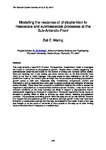Modelling the response of phytoplankton to mesoscale and submesoscale processes at the Sub-Antarctic Front
| dc.contributor.author | Waring, Z. | |
| dc.date.accessioned | 2019-05-20T10:11:52Z | |
| dc.date.available | 2019-05-20T10:11:52Z | |
| dc.date.issued | 2016 | |
| dc.identifier.citation |
Waring, Z. (2016) 'Modelling the response of phytoplankton to mesoscale and submesoscale processes at the Sub-Antarctic Front', The Plymouth Student Scientist, 9(2), p. 49-67. | en_US |
| dc.identifier.issn | 1754-2383 | |
| dc.identifier.uri | http://hdl.handle.net/10026.1/14128 | |
| dc.description.abstract |
This study extends a basic NPZ (Nutrient, Phytoplankton, Zooplankton) model to investigate the impact of turbulence on phytoplankton growth. Despite recent studies suggesting that submesoscale dynamics are crucial for the transfer of energy and nutrients across eddies, there are relatively few in situ studies and none, before now, at the Sub-Antarctic Front (SAF) to the East of Drake Passage. This study draws on data collected at the SAF and predictions made by the model to give an insight into the processes governing phytoplankton growth across a cold core mesoscale eddy. Conductivity, temperature, nutrient and chlorophyll-a (chl-a) measurements were used to assess physical and biological differences across the eddy. These were then compared to predictions made by the model to assess the response of phytoplankton to the dynamical conditions across the eddy. It was found that the turbulent conditions at the eddy boundary are likely to support a phytoplankton bloom, subsequently triggering an increase in zooplankton. Increased zooplankton levels cause an increase in grazing which is likely to enforce top down control, reducing phytoplankton numbers. The processes controlling growth within the eddy are not so well defined, however it is thought that phytoplankton growth is sustained, although growth in situ may have been limited by a micronutrient such as iron that was not included in the model. A lack of iron was also thought to be the cause of low levels of chl-a outside of the eddy as no other limiting factors were identified in measured or modelled data. | en_US |
| dc.language.iso | en | en_US |
| dc.publisher | University of Plymouth | |
| dc.rights | Attribution 3.0 United States | * |
| dc.rights.uri | http://creativecommons.org/licenses/by/3.0/us/ | * |
| dc.subject | phytoplankton growth | en_US |
| dc.subject | Nutrient | en_US |
| dc.subject | Phytoplankton | en_US |
| dc.subject | Zooplankton | en_US |
| dc.subject | NPZ | en_US |
| dc.subject | submesoscale dynamics | en_US |
| dc.subject | Sub-Antarctic Front | en_US |
| dc.subject | East of Drake Passage | en_US |
| dc.subject | zooplankton levels | en_US |
| dc.subject | phytoplankton bloom | en_US |
| dc.subject | chlorophyll-a (chl-a) measurements | en_US |
| dc.title | Modelling the response of phytoplankton to mesoscale and submesoscale processes at the Sub-Antarctic Front | en_US |
| dc.type | Article | |
| plymouth.issue | 2 | |
| plymouth.volume | 9 | |
| plymouth.journal | The Plymouth Student Scientist |



